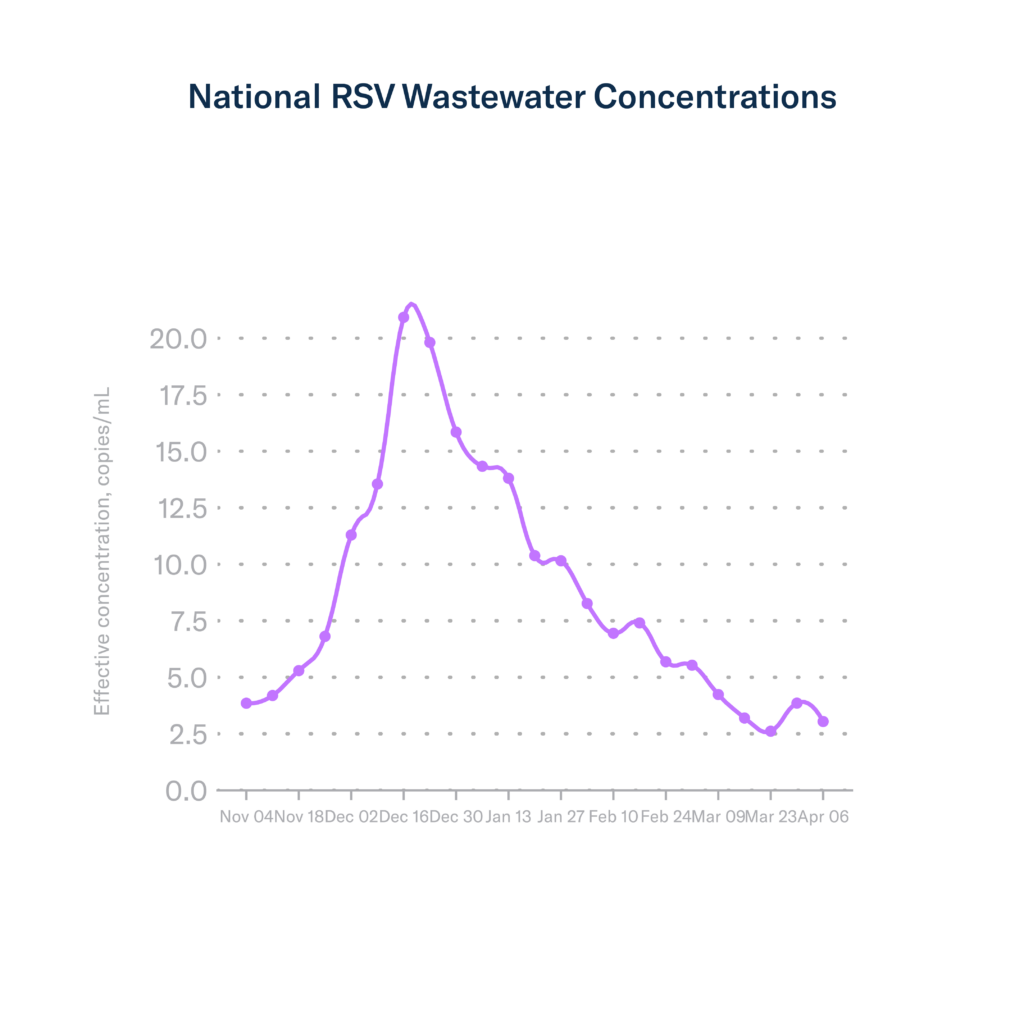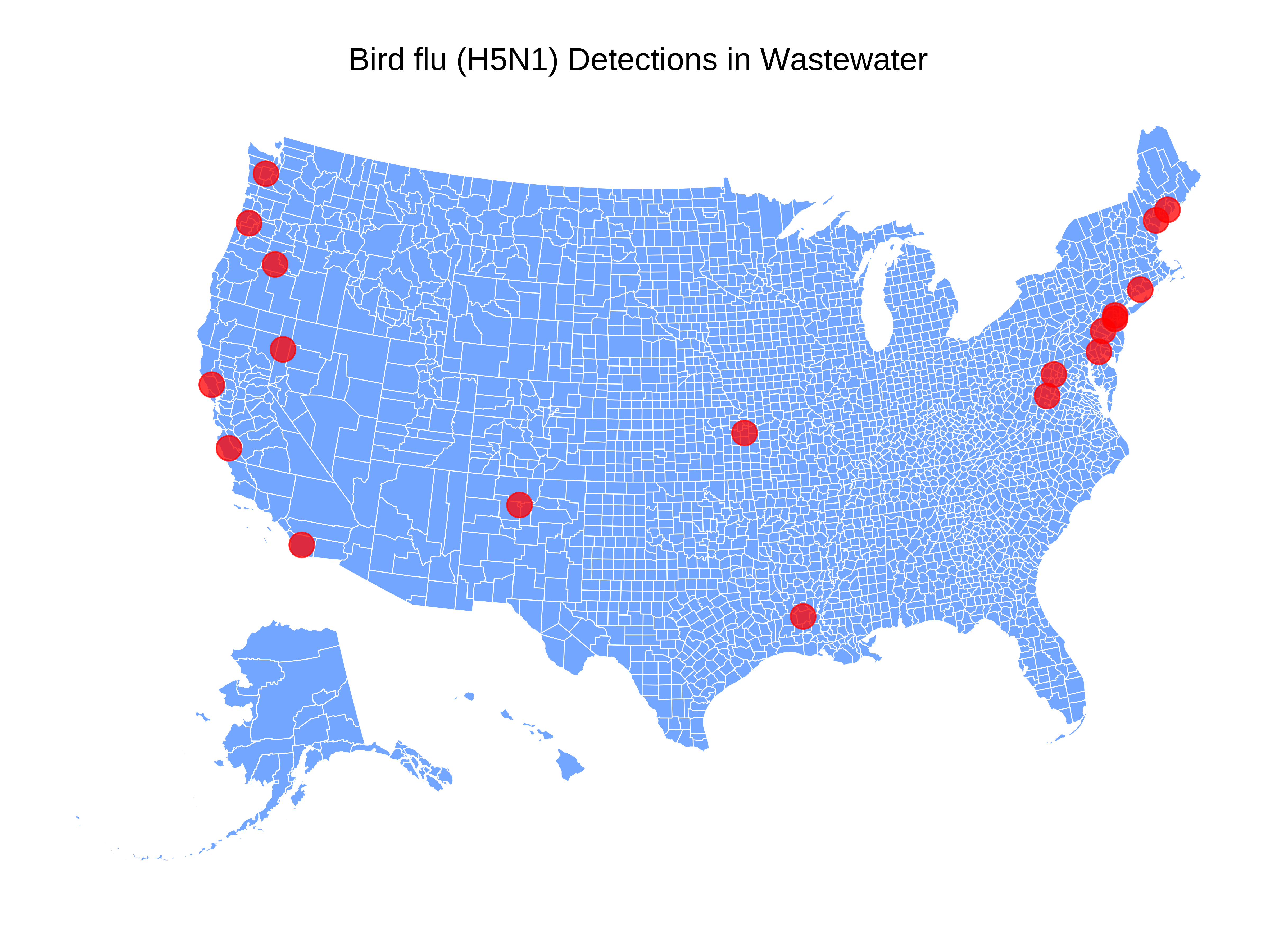At Biobot, we analyze wastewater across the country for various infectious disease pathogens....

Respiratory Virus Risk Reports
Comprehensive Insights for COVID-19, Influenza, and RSV
COVID-19, Influenza, and RSV Wastewater Monitoring in the U.S. | Week of April 8, 2024
This respiratory season, we are analyzing wastewater for the presence of respiratory syncytial virus (RSV) and influenza virus (types A and B). Together with COVID-19, these three pathogens are outsized contributors to our seasonal respiratory illness burden. In this data series, we’ll guide you through the wealth of data we’ve gathered from our Biobot Network of national sampling sites, aiming to shed light on emerging trends in respiratory virus activity and community viral load. Our goal is to equip you with information to make informed decisions, especially as we approach the holiday season and gather with family and friends.


Data Note: Samples are collected from participating locations and processed by our lab team on a rolling basis. Each point on the figure represents the weekly average concentration from Sunday – Saturday (corresponding to the MMWR week), aligned to that week’s Saturday.
Contributors

Marisa Donnelly, PhD
Public Health Partnerships Epidemiologist

Max Imakaev, PhD
Data Scientist
Previous Risk Reports
Summary: Week of 4/8/24
This week’s report covers data from this week and the previous week (weeks 13 and 14). After identifying some local influenza A wastewater trends that were not representative of the national or regional concentrations, we have rewritten this report to reflect current wastewater trends better. Biobot’s national wastewater network showed plateaus in influenza A concentrations during week 13 and spikes in influenza B and RSV concentrations. SARS-CoV-2 concentrations, on the other hand, continued to decline during week 13. The spikes we observed could be due to increased travel and gathering, as week 13 encompassed spring break for many parts of the country. This week’s data (week 14) show that influenza A & B and RSV wastewater concentrations began declining again while SARS-CoV-2 levels plateaued. In good news, nationally, all major clinical metrics for COVID-19 and influenza showed signs of declining illness burden during week 14, and clinical metrics for RSV showed that burden remains quite low. The fluctuations we’ve observed highlight the importance of real-time wastewater monitoring for infectious diseases, as trends can change rapidly and behave in unexpected ways. Wastewater and clinical monitoring continue to show that this respiratory season has been abnormal, with an unusually long flu season and fluctuations in viral activity.
The Bottom Line: The respiratory season is not over yet, and continued wastewater monitoring is important to keep us informed. It remains important to remember that the transmission and circulation of viruses, particularly SARS-CoV-2 and influenza, are still active. If you’re feeling unwell, it’s important to minimize contact with others, consider wearing a mask in crowded spaces, and stay current with vaccinations and boosters. Taking these precautions can help keep you and your loved ones healthy.
National Outlook
RSV
After a brief increase during week 13, national RSV wastewater concentrations came back down again in week 14 (through April 6th), and are now close to the lowest levels we’ve observed since we began RSV testing in late October. National clinical RSV metrics continue to remain quite low during week 14.

Influenza
After a plateau in concentrations during week 13, national influenza A wastewater concentrations began declining again in week 14 and are now at levels observed in early December. Wastewater concentrations for influenza B significantly increased during week 13, after 3 consecutive weeks of decline. Thankfully, concentrations decreased again in week 14. We will continue to monitor influenza B closely.
Despite some fluctuations in wastewater concentrations, clinical data continued to show good signs of decreasing influenza activity in the US during week 13, with most metrics continuing to trend downward. The number of hospitalizations due to flu decreased, with about 5,300 hospitalizations occurring in week 13. Test positivity from clinical labs also continued to decrease, going from 10.5% to 9.1% currently. The percentage of outpatient visits for influenza-like illness (ILI) – typical in flu, RSV, and COVID-19 patients – held steady during week 13, currently at 3%.

COVID-19
Wastewater data show that COVID-19 activity and community viral load held steady during the previous week, remaining at the lowest concentrations observed during this winter surge. As of week 14, the national SARS-CoV-2 wastewater concentration average is 320 copies/mL.
Clinical metrics showed great signs of decreasing COVID-19 disease burden, with all major metrics continuing to trend downward during week 13. COVID-19 hospitalizations dropped from around 9,500 in week 12 to just over 8,000 in week 13. The national COVID-19 test positivity rate continues to decline and is currently at 3.5%. Deaths due to COVID-19 significantly declined in week 13 and currently represent 1.2% of all deaths in the US.
Regional
The South
RSV: In the South, RSV wastewater concentrations continued to decrease during week 13 and held steady in week 14. Concentrations are currently some of the lowest values we’ve observed for the region since we began samping.
Influenza: After a small uptick in influenza A concentrations during week 13, the South experienced decreasing trends again during week 14. Influenza B concentrations held steady during week 13 and then slightly increased during week 14 in the South. We’ll continue to keep an eye on influenza B in the South, but overall, influenza concentrations remain low in the region. During week 3, three states in the South experienced an increase in outpatient visits due to ILI, including Tennessee, South Carolina, and Mississippi. The great news is that all Southern states are now at the minimal or low ILI level.
COVID-19: SARS-CoV-2 wastewater concentrations slightly declined in the South during weeks 13 and 14, currently at 271 copies/mL. All but one state in the South reported decreases in hospitalizations due to COVID-19, with West Virginia reporting no change from the previous week. COVID-19 activity continues to decrease in the South.
The Midwest
RSV: RSV wastewater concentrations increased in the Midwest during weeks 13 and 14 and are currently at levels observed in late February. We will continue to monitor RSV in the Midwest closely, as it appears that the region still has elevated levels of viral activity.
Influenza: Influenza A wastewater concentrations plateaued in the Midwest in weeks 13 and 14, while influenza B wastewater concentrations declined in week 13 but increased in week 14. During week 13, most states in the Midwest experienced a decrease in outpatient visits due to influenza-like illness or held steady. Exceptions to this are Missouri and North Dakota, which both experienced increases in outpatient visits. Three states (North Dakota, Nebraska, and Michigan) remain in the High ILI activity level, with all other states at Minimal, Low, or Moderate levels. We’ll be keeping an eye on the Midwest.
COVID-19: SARS-CoV-2 wastewater concentrations slightly decreased in the Midwest during weeks 13 and 14, currently at 315 copies/mL. During week 13, most states in the Midwest experienced a decrease in COVID-19 hospitalizations, with only two (Nebraska and South Dakota) experiencing small increases. Despite some fluctuations, COVID-19 activity in the Midwest still appears to be decreasing.
The Northeast
RSV: In the Northeast, RSV wastewater concentrations significantly increased during week 13 but thankfully came back down in week 14. Concentrations are back to some of the lowest values we’ve observed for the region since we began sampling.
Influenza: In the Northeast, influenza A wastewater concentrations decreased in weeks 13 and 14 and are currently at similar levels to what we observed in late November. Influenza B concentrations, however, plateaued in week 13 and slightly increased in week 14. We will continue to keep an eye on influenza B in the Northeast. In week 13, three Northeast states experienced increased outpatient visits due to ILI, including Maine, Rhode Island, and Connecticut. Only two states in the Northwest (New Jersey and Massachusetts) remain at the Moderate ILI level, with all other states at the Low or Minimal levels.
COVID-19: SARS-CoV-2 wastewater concentrations held steady in the Northeast during week 14, currently at 433 copies/mL. Most states in the Northeast experienced declines in COVID-19 hospitalizations, except Rhode Island, which experienced a slight increase.
The West
RSV: RSV wastewater concentrations held steady and remained low in the West during weeks 13 and 14.
Influenza: Wastewater concentrations for influenza A remained stable and low in the West during weeks 13 and 14 and are at similar levels to those observed in late November. Influenza B concentrations, however, substantially increased in week 13 and subsequently decreased in week 14. Most states in the West experienced declines in outpatient visits due to ILI in week 13, with the exceptions of Arizona and Nevada, which experienced increases. Currently, most states are in the Minimal or Low ILI categories, with only New Mexico and Wyoming remaining in the High level.
COVID-19: During weeks 13 and 14, SARS-CoV-2 wastewater concentrations slightly decreased in the West, currently at 183 copies/mL. Most states in the West also experienced decreased hospitalizations due to COVID-19 in week 13. Exceptions to this include Wyoming and Colorado, which experienced increases. Despite some fluctuations in clinical data, COVID-19 activity in the West still appears to be decreasing.


Footnotes:
Wastewater data from Biobot Analytics for RSV, influenza, and SARS-CoV-2 are through April 6, 2024 (MMWR week 14). Clinical data on testing, hospitalizations, and emergency department visits for RSV, influenza, and COVID-19 are from the Centers for Disease Control and Prevention. Updates to clinical data for RSV, influenza, and COVID-19 are through March 30, 2024 (MMWR week 13).






